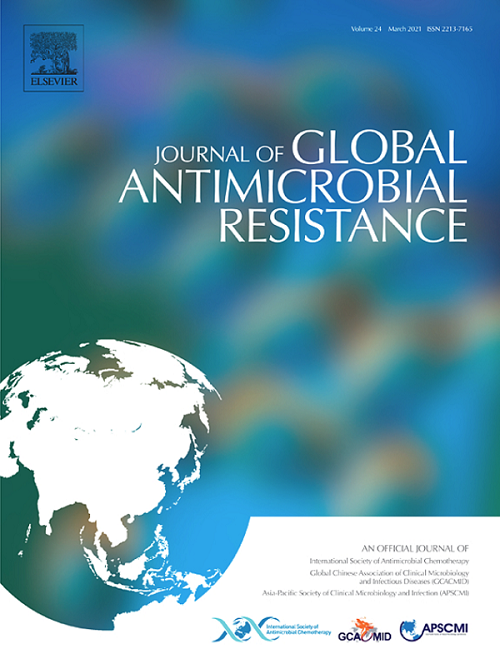炎症性肠病患者艰难梭菌感染的分子分型和临床特征:一项回顾性研究。
IF 3.7
3区 医学
Q2 INFECTIOUS DISEASES
引用次数: 0
摘要
背景与目的:艰难梭菌感染(CDI)发病率的增加与炎症性肠病(IBD)患者预后不良有关。但国内相关数据有限。本研究旨在阐明中国IBD患者难辨梭菌的分子类型和临床特征。方法:收集粪便标本,进行厌氧培养,检测谷氨酸脱氢酶和艰难梭菌毒素A、b,对产毒艰难梭菌进行多位点序列分型和药敏试验。收集临床资料,比较IBD和非IBD患者发生CDI的情况,确定IBD患者发生CDI的相关危险因素。结果:IBD患者的CDI发生率明显高于非IBD患者(分别为27.2%和9.0%)。在IBD患者中,优势序列类型(STs)为ST54(20.2%)、ST2(14.9%)、ST3(14.9%)和ST42(13.2%)。耐多药率最高的STs为ST37(100%)、ST35(100%)和ST42(73.3%)。在IBD患者中,6个月内住院和使用5-氨基水杨酸是CDI的独立危险因素。其他危险因素包括质子泵抑制剂、免疫抑制剂和皮质类固醇的使用。结论:IBD患者CDI发生率明显高于非IBD患者。应加强对住院患者CDI的监测,降低IBD患者CDI的发生率。本文章由计算机程序翻译,如有差异,请以英文原文为准。
Molecular typing and clinical characteristics of Clostridioides difficile infection in patients with inflammatory bowel disease: A retrospective study
Objectives
The increasing incidence of Clostridioides difficile infection (CDI) has been associated with poorer prognosis of patients with inflammatory bowel disease (IBD). However, relevant data are limited in China. The aim of this study was to clarify the molecular types and clinical characteristics of C. difficile in IBD patients in China.
Methods
Stool samples were collected, cultured anaerobically, and tested for glutamate dehydrogenase and C. difficile toxins A and B. Toxigenic C. difficile isolates were subjected to multi-locus sequence typing and antimicrobial susceptibility testing. Clinical data were collected to compare IBD and non-IBD patients with CDI, and to determine the risk factors associated with CDI in IBD patients.
Results
The incidence of CDI was significantly higher in IBD patients than non-IBD patients (27.2% vs. 9.0%, respectively). Among IBD patients, the dominant sequence types (STs) were ST54 (20.2%), ST2 (14.9%), ST3 (14.9%), and ST42 (13.2%). The STs with the highest multidrug resistance rates were ST37 (100%), ST35 (100%), and ST42 (73.3%). In IBD patients, hospitalization within 6 months and use of 5-aminosalicylic acid were independent risk factors for CDI. Other risk factors included the use of proton pump inhibitors, immunosuppressants, and corticosteroids.
Conclusion
The incidence of CDI was significantly higher in IBD patients than non-IBD patients. Surveillance of CDI in hospitalized patients should be strengthened to reduce the incidence of CDI in IBD patients.
求助全文
通过发布文献求助,成功后即可免费获取论文全文。
去求助
来源期刊

Journal of global antimicrobial resistance
INFECTIOUS DISEASES-PHARMACOLOGY & PHARMACY
CiteScore
8.70
自引率
2.20%
发文量
285
审稿时长
34 weeks
期刊介绍:
The Journal of Global Antimicrobial Resistance (JGAR) is a quarterly online journal run by an international Editorial Board that focuses on the global spread of antibiotic-resistant microbes.
JGAR is a dedicated journal for all professionals working in research, health care, the environment and animal infection control, aiming to track the resistance threat worldwide and provides a single voice devoted to antimicrobial resistance (AMR).
Featuring peer-reviewed and up to date research articles, reviews, short notes and hot topics JGAR covers the key topics related to antibacterial, antiviral, antifungal and antiparasitic resistance.
 求助内容:
求助内容: 应助结果提醒方式:
应助结果提醒方式:


